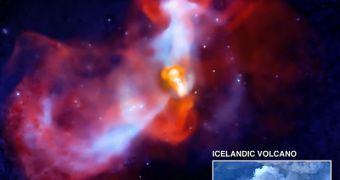Experts operating the NASA Chandra X-ray Observatory announce the discovery of an impressive galactic supervolcano, a structure that emits vast amounts of gas outwards from its location, and which looks as if it's currently erupting.
The object was also observed by astronomers using the Very Large Array (VLA), a massive observatory operated by the US National Science Foundation (NSF), Space Fellowship reports.
According to experts who had a chance to look at the new data, it would appear that the volcano-like structure is in fact caused by a supermassive black hole, which is located squarely in the center of the host galaxy.
The influence of the dark behemoth is arguably preventing hundreds of millions of new stars from being produced from their respective nurseries.
The cosmic fireballs appear when impressively-large clouds of hydrogen gas collapse onto themselves, igniting in the process, and initiating nuclear fusion.
Stirring the gas is good for boosting stellar genesis, but only up to a certain point. The black hole is disrupting this process entirely, as the hydrogen clouds are not allowed to implode and ignite.
The troubled galaxy, called M87, is located no less than 50 million light-years away from Earth. It is a component of the massive Virgo supercluster of galaxies.
In a few billion years, the Milky Way will unite with the cluster as well, after merging with the neighboring Andromeda galaxy first.
“Our results show in great detail that supermassive black holes have a surprisingly good control over the evolution of the galaxies in which they live,” explains scientist Norbert Werner.
He holds an appointment at the SLAC National Accelerator Laboratory, and at the Kavli Institute for Particle Astrophysics. The expert also authored one of the two papers detailing the findings.
“And it doesn’t stop there. The black hole’s reach extends ever farther into the entire cluster, similar to how one small volcano can affect practically an entire hemisphere on Earth,” he goes on to say.
“This gas could have formed hundreds of millions of stars if the black hole had not removed it from the center of the galaxy. That seems like a much worse disruption than what the airline companies on Earth had to put up with earlier this year,” adds Stanford University graduate student Evan Million.
The two papers will appear in an upcoming issue of the esteemed scientific journal Monthly Notices of the Royal Astronomical Society, Space Fellowship reports.

 14 DAY TRIAL //
14 DAY TRIAL //